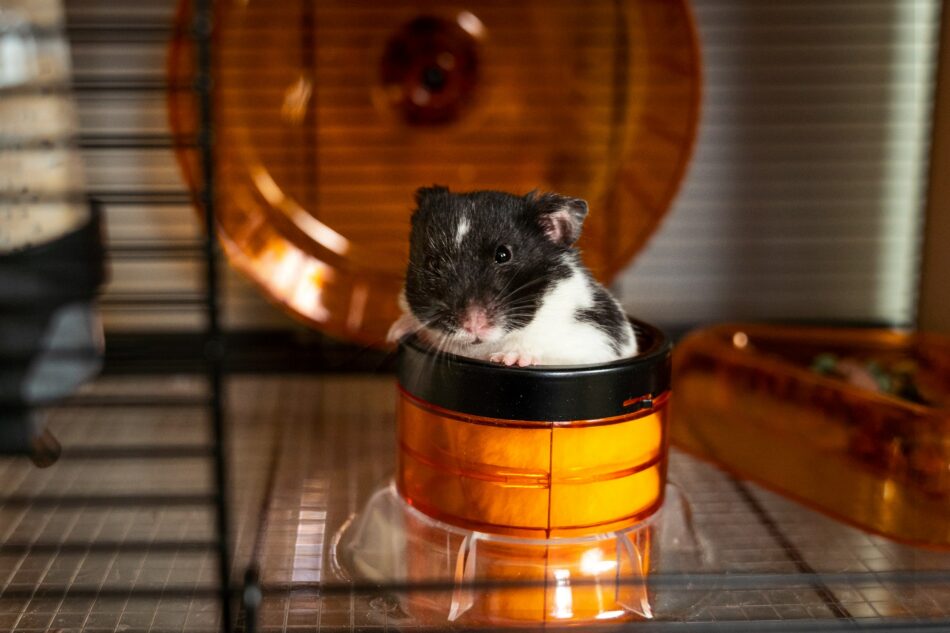What illnesses do hamsters get, and how can they be treated?
If you’ve recently added a hamster to your family, or are considering getting one, you may be wondering what illnesses hamsters get, and how they can be treated. Thankfully, since hamsters are active pets with hearty appetites, it’s usually apparent when they aren’t feeling their best. We’ve outlined some of the most common ailments that hamsters may experience, and what to do if you notice anything amiss with your small mammal friend.
How healthy are hamsters?
Hamsters are generally healthy animals that live full, but relatively short lives. Depending on the breed of hamster you have, the life expectancy for even healthy hamsters is between 2-4 years. But, over the course of your time together, you may see your hamster acting “off” or even display obvious signs of illness. It’s important to perform regular health checks on your hamster to identify any potential problems early on.
By checking in with your hamster daily, you’ll be able to see if there are any issues with their coat, teeth, eyes, or paws, and note any behavioral changes. It’s a good idea to get your hamster established with a veterinarian that treats hamsters as soon as you get them – that way both you and your veterinarian will have a baseline for your hamster’s health. And, if you notice anything wrong with your hamster, a quick phone call or visit with the vet will help put your mind at ease.
Most common illnesses in hamsters
This is not an exhaustive list, but the following illnesses and ailments are those that hamsters are most commonly seen with. By recognizing the signs and symptoms of each, you’ll be able to determine the best course of action.
Abscess
Hamsters can develop infections if they have cut or poked themselves, which can allow abscesses to form. Hamsters that chew on the bars of their cage may develop an abscess in the mouth, or you may see an abscess on the sides or legs of hamsters that have cage mates from rough play or fighting.
Note: Abscesses need to be treated by a vet – do not attempt to drain an abscess at home.
Colds
Your hamster can actually catch a cold from you. The same virus that causes the common cold in humans can be transmitted to hamsters. Signs and symptoms of a cold in hamsters are similar to those in humans:
- Watery eyes
- Discharge from the nose
- Coughing
- Wheezing
- Sneezing
- Lethargy
Your hamster’s coat may also appear to stay wet as they continually wipe their runny nose on their fur.
Treatment for a cold in hamsters includes:
- Keeping their bedding fresh, taking care to use a dust-free variety
- Offer plenty of food and water
- Supplement their food with cod liver oil
Colds will usually pass quickly and on their own, but if your hamster stops eating or drinking, it may be time for a trip to the vet to rule out secondary infection. Try to avoid handling your hamster when you have a cold to prevent passing it along to them.
Cuts
Skin abrasions are more common in hamsters that live together. Scuffles, rough play, or challenges to the hierarchy can result in cuts. If you don’t have a safe and secure hamster cage, you may see a hamster with cuts even if they live alone. These are usually from weak or bent cage wires, ill-fitted tubing, or sharp plastic edges.
Cuts can usually be cleaned at home with warm soapy water. However, hamsters will lick and tend to their wounds, so anything more than a superficial wound may not heal well without antibiotics or other treatment from the vet.
Problems with the ears
A hamster that scratches at their ears constantly, seems sensitive around their head when being held, or appears off-balance or walking in tight circles, an inner-ear infection may be to blame. Your veterinarian can prescribe antibiotics or anti-inflammatories to treat ear infections. While seeing your hamster in distress may be upsetting, ear infections usually clear up quickly.
Dry ears are another common problem. Along with incessantly scratching at their ears, you may also notice the skin around your hamster’s ears cracking or flaking. To remedy this, rub some vaseline on their ears with a cotton swab for a few days.
Problems with the eyes
Any swelling in or around your hamster’s eyes, discoloration of the eye itself, or thick or colored discharge is not normal, and warrants a call to the vet. Some possible causes include:
- Trauma to the eye (a puncture or scratch)
- Foreign object in the eye
- Trouble with their cheek pouch
- Oral abscess
- Allergic reactions
- Tumors
- Glaucoma
If your hamster’s eye is so goopy that it is matted shut, apply a warm compress (water on a soft rag) for a few minutes to gently remove the crusted material. Don’t try to force your hamster’s eye open once the material is removed – they should be able to open their eyes on their own after a few minutes of having them cleaned.
Lumps
Being familiar with normal hamster anatomy will help you determine if something isn’t right. Some lumps and bumps are normal (especially in males or lactating females), but you’ll know quickly while handling your hamster if something has popped up suddenly.
Lumps don’t all have scary causes, but you should always have them checked out by a veterinarian. They’ll likely take a small sample with a tiny needle to determine the makeup of the lump. Some potential causes are:
- Lipomas (benign, fatty tumors)
- Cysts
- Abscesses
- Enlarged glands
- Tumors
Mange
The parasites that cause mange can’t be seen with the naked eye – but they do cause obvious discomfort in your hamster. Symptoms of mange in hamsters include:
- Scratching at their bodies excessively
- Hair loss
- Red or scaly patches of skin
- Matted hair coat
The mites that cause mange can be seen under a microscope, so your vet will likely take a small sample of the inflamed skin of your hamster. If your hamster is diagnosed with mange, they will need baths with a special shampoo that your vet will prescribe.
Fleas or lice
These parasites can infect your hamster if other pets in your household have them. It’s important to keep your dogs and cats on a flea preventative to avoid your small pets from getting them. The same preventatives are not safe for hamsters, so be sure not to apply any flea products on your hamster without direction from your veterinarian.
If your hamster has many visible parasites, you can bathe them in warm water with a small amount of unscented dish soap (be sure to dry them thoroughly so they don’t get chilled). The lather from the soap will kill the existing parasites – but won’t prevent more from hitching a ride on them later. Treat all the animals in your home for fleas and lice to prevent reinfestation.
Strokes
Due to their short lifespans, hamsters age rapidly – and sometimes all of a sudden. Part of this aging process may include strokes. Symptoms of a stroke include:
- Unsteady gait
- Circling
- Swaying or other involuntary, repetitive motion
Most strokes are small enough to not leave your hamster significantly impaired. But, no matter the size, there is no treatment or prevention for strokes in hamsters. If your hamster has suffered a stroke, they may need to have their housing adjusted to make them more comfortable. Keeping their food bowl topped off and waterer full will help them stay nourished, and you may need to remove obstacles like their wheel or tubing to prevent injury.
Issues in the mouth
A hamster with a poor appetite is surely feeling under the weather. But, sometimes the cause of a poor appetite is actually inside of their mouth. Hamsters are rodents, and as such, their teeth grow constantly. They need to be able to gnaw on applewood toys and be fed a quality pellet as the main staple of their diet to keep their teeth filed down. Reasons other than overgrown teeth that may cause oral discomfort in hamsters include:
- Infected cheek pouches
- Loose or infected teeth
- Oral abscesses `
- Injury to the mouth or jaw
If your hamster seems reluctant to eat, but appears and acts fine otherwise, they’ll need to be seen by your veterinarian.
Urinary problems
If you spot blood on your hamster’s bedding, it could be due to an injury, a burst abscess, or a urinary infection. An examination of the hamster’s bedding will tell you if it is the latter problem. A change in urine color, or a lack of urine, indicate health issues too.
Keeping your hamster’s cage clean is good practice for their overall health, but their bedding can tell you a lot about their health. The color, odor, consistency and amount of urine in their cage can point to potential issues with their urinary tract. Signs of a hamster experiencing urinary tract issues include:
- Blood in the urine
- Thick, cloudy urine
- Decrease in urine output
- Urine with a foul odor
Urinary tract infections can turn serious quickly, so it’s best to have your hamster evaluated by a veterinarian if you notice a change in their eliminations.
Wet tail
“Wet tail” is a term for serious, bacterial diarrhea that causes feces-soaked fur around the tail. This condition can prove fatal quickly for hamsters – not only from the bacterial infection, but from dehydration.
Offer plenty of water until you can get your hamster to the veterinarian. Wet tail should not be treated at home, as time is of the essence to save your hamster from this illness.
Preventing illness in your hamster
The absolute best way to treat illnesses in your hamster is to try to prevent them entirely. Housing your hamster in a cage like the Qute Hamster Cage by Omlet will make cleaning quick and easy – keeping your hamster clean and healthy. The removable bedding tray makes complete bedding changes a breeze, and the wipe-clean plastic surfaces don’t give bacteria a chance to set up shop.
If you have a social hamster breed, be sure to quarantine new hamsters for a minimum of two weeks before introducing them to your other hamsters. Feed all of your hamsters high-quality feed and offer fresh water daily to keep their immune systems and digestion working properly.
Omlet and your hamster’s health
Our Qute Hamster Cage was designed with both humans and hamsters in mind. Our all-in-one hamster home gives your furry friend everything they need to thrive, and cuts down on your time spent cleaning so that you can get back to bonding with your hamster. And, even if your hamster does become ill, the Qute will keep them comfortable while they’re under the weather, and help you keep their home clean with minimal effort – giving you more time to show them the extra love and care they need.
This entry was posted in Hamsters

